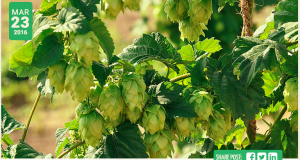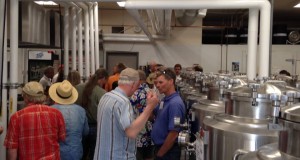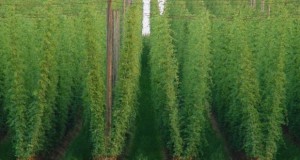Selecting the Right Trellis Design to Grow Great Hops
By: Great Lakes Hops | July 21, 2013
Creating the optimal hop yard that produces maximum yields with minimal infrastructure, labor, and inputs is critical to long term success & profitability of a hop yard. Hopefully the following discussion can help improve understanding of how to achieve the optimally yielding hop yard for those just starting.
Choosing the right Trellis design begins with and ends with an understanding of the hop plant itself. It is very important to understand how hops grow, what makes them produce optimal yields, and what the differences are between varieties and genotypes.
Some thoughts to immediately discard:
- “Poles are expensive so let’s really space them out”
- “don’t need such long poles if I don’t put ‘em 3 feet in the ground”
- “This thinner wire should work . . .”
- “the rows have to be really wide ‘cause I got a big tractor”
- “let’s grow 10 varieties in 4 rows”
- “we won’t need irrigation”
- “fertilizer is just too expensive.”
- “healthy hop plants don’t get bugs or disease.”
- “I’m gonna plant the hops first and then put in the trellis and irrigation . . .”
If you can’t get past these – stop here to prevent wasting a lot of time and your life savings, otherwise continue reading!
The first and simplest idea is to match the correct trellis design and hop plant density per acre to the hop varieties being considered. Hops will thrive in a mature hop yard when this is done correctly because it creates a very favorable microclimate in the hop yard. The hop yard is a three-dimensional environment like a forest. Think in terms of upper canopy, mid-canopy, and lower understory; or floor. Hop plant and row spacing has impacts at each level and will vary by cultivar and genetic type. A one-size trellis design does not fit all. Spacing between rows and individual hop plants in the row is determined by a combination of plant size, sidearm length, and disease considerations. If planted too closely the hop sidearms will intertwine with neighboring hop plants and strings; resulting in a tangled mess at harvest time. Spacing too closely also creates higher moisture levels and less air movement in the lower canopy; creating an environment that mildews and fungal diseases thrive in. Spacing hops too far apart creates its own evilness. It exponentially lowers yield per acre, increases weed problems, and creates hot conditions in the lower canopy and soil. Hot and dry conditions in this zone will increase mite and pest problems and restricts the development of the shallow root system and mycorrhizae that hops depend on for their rapid growth. Overly-spaced hop yards often experience summer shock, yellowing, and stalled growth from over-heating and do not reach wire height or develop cones properly.
For purposes of this discussion, I am putting hops into 3 main growing groups – American types (A), British types(B), and Continental Europe type (C). This is a gross over-simplification, but this generalization is necessary to keep your attention!
American type hops (A type) tend to be large robust, high yielding hops with rather long sidearms; some approaching 48 inches in length. They have vigorous root systems that match their bine size and are quite tolerant of different soil types, pH ranges and growing conditions. “A”-types would include Galena, Willamette, Chinook, Brewers Gold, Columbus, & Zeus. These large hop varieties require space and are usually planted in 14 foot row spacing with 42 inches minimum between plants. Cascade and Centennial are also often planted at this 14 foot row spacing because of their finer plant habit and susceptibility to pests and diseases if crowded too closely. Both of these varieties have shorter side arms so they are normally planted at 36 inch spacing in the rows.
“B” & “C” types-(British & Continental Europe types) differ genetically from American types. In general, they are smaller plants with matching smaller, finer root systems. The finer root systems are not as tolerant of different soils, pH levels, and excessive moisture levels. Yields and cone size tend to be lower and smaller per plant; with shorter side arms. Although the yield per hop plant is lower, they can be grow at much higher densities per acre; resulting in about the same yield per acre as the more widely spaced American types.
What is the difference between “B” & “C” types?
“B” types originate from Britain, where they have been grown for centuries in a more alkaline chalky soil (think cliffs of Dover) that is high in calcium phosphates. These hops are adapted to a well -drained soil that has relatively higher pH range – 6.5 or higher. Some B types include: Fuggle, Challenger, Viking, and all the Golding types. They will tolerate heavier fine soils if grown in raised rows.
“C” types originate from Continental Europe and come from countries like Germany, France, and Belgium. Some of these varieties would include Magnum, Perle, Hallertauer types, and Glacier. These hops have been grown for centuries in well drained soils that have a low pH 5.5 to 6.2. This soil type is a more forest-type soil rich in humic acids derived from decomposed leaves or peat moss. Pretty much the opposite of type B hops and even type A hops.
(These differences and adaptations between types- A, B, and C’s is what perpetuates the notion that some hops can’t be grown here successfully. (Great Lakes Hops currently has over 75 different hop varieties growing successfully in Michigan trials.) Usually the source of this information comes from growers who have attempted to plant a hop yard that contains all these types together and yet try to treat them all the same – a huge mistake!)
B & C types should be planted in trellis configurations with narrower row spacing – 12 foot or even 10 foot or less between rows in some cases. It is critical to form that “forest effect” described earlier. Spacing between hop plants in the rows is again determined by the variety’s sidearm length – the shorter the sidearms; the closer they can be spaced. Many of these varieties can be planted with in-row spacing ranging from 24 inches to 36 inches between plants. These plant spacings are considered high density hop yards here in America, and some special techniques are used to grow them. Hops are grown raised or hilled a minimum of 6 to 12 inches. Lower foliage is removed from the bottom 3 feet of bines to ensure good air movement. Rows less than 10 feet wide are clean-tilled; not inter-planted with a cover crop like clovers. (Row covers elevate the incidence of mildews by 30% or more.) Weeds and mites are often not as troublesome because the higher plant density creates a cooler, shaded mid-canopy and understory that is unfavorable for them. Also, predator and beneficial insects move from plant-to-plant more effectively. The majority of hop varieties are B & C types -all the Noble type hops, and most aroma types fall into this category. Hop growers can really limit their opportunities with craft brewers when they lock into a typical 14 foot row space trellis design.
1. Now, the actual design strategy. Questions:
What hop(s) are my potential customers willing to purchase? A, B, C or a mix of types? (It does not make any sense to grow hops nobody wants . . .) Can the different types be separated or grouped into individual growing areas or zones to meet each hops specific needs?
Can I grow these hops on the land / soil type I have to work with? Can I amend the soil or use other techniques to be successful? Am I familiar with the sidearm lengths and cultural requirements of each hop variety chosen?
Have I chosen any hop varieties with unusual attributes like very long sidearms or high susceptibility to disease/ pests if over-crowed? (These types may do better in clump-style planting trellis designs). Is there a newer variety of the same hop type that performs better?
If you can answer the above questions then . . .
2. Pole Height
Pole height is recommended to stay with a standard trellis height of 18 feet under the wire/cable unless you have consulted carefully about which hops can be grown hedgerow or on short trellis designs. Hop varieties vary as to where cones develop – low, mid, or high on the bines. Growing a high cone set variety on a short trellis would be a disaster! Also plan how you will harvest and process non-standard bine lengths. Most processors with Wolf- type pickers won’t accept non-standard bines.
3. Row Spacing
Type A, B, or C? A mix of hop types A, B, C will require a compromise on less-than-optimal spacing and growing conditions for some varieties. This translates directly into less-than-optimal yields overall! This is why most experienced growers limit the amount of hop varieties they grow; choosing hop varieties that grow similar to each other; or set up different trellis configurations and separate yards for individual hop types. In some instances, hops can also be planted mid-aisle and utilize the same existing trellis support wires. This creates a high density planting with a third more plants per acre; boosting yields without additional trellis structure. Consult with GLH or growers who have these types of hop yard plantings before trying this alternate growing style.
4. Pole spacing in the row
This is determined by hop plant spacing in the row (density) and the cultivation style you are going to use. Growers using evenly spaced plants will space poles at up to 42 feet apart for long sidearm varieties like Willamette, Chinook, & Galena; which are spaced at 42”-48”. Types like Cascade and Centennial ; which are planted at a 36”, should have pole spacing reduced to around 36 feet to prevent excess sagging. If uneven, or clump spacing is used the following formula is helpful.
# of 3 foot hills plus 7 foot minimum between each hill plus 4 to 6 feet = pole space < 44 feet
Clump, uneven or hilled growing is another specialized hop yard design that allows cross cultivation of the hop yard in the 7’ cross row spaces and offers some economy in mechanical weed control and Spring field cultivation, rhizome removal, and reduced amount of hop twine required. Consult with GLH or growers who use this growing style for the pros and cons.
Pole spacing in higher density hop yards can also use an alternating stagger row-to-row; creating a diamond pole pattern which reduces the total number of poles required per acre.
5. Choice of Irrigation Styles
Suspended, laid on the ground, buried dripper tape or overhead sprinkler.
Dripper lines suspended 14”- 18” above rows offer the advantages of easy inspection/maintenance; stay in place year-around; give a coir twine fastening point; and avoid damage from mechanical cultivation. Possible con: cannot cross cultivate hop yard. On the ground drip lines are easily rolled up each season; allow clump-style growing & cross cultivation. Possible cons: harder to inspect, no tie spot for coir twine; prone to more mechanical damage from cultivation. Buried drip tape –not recommended. Cannot inspect, often damaged during rhizome removal, not designed to match the longevity of a hop yard. Overhead sprinklers. Overhead irrigation or center pivot can be used successfully by growers who understand wet leaf diseases and time irrigation cycles to minimize wet leaf periods. Possible cons: has to be elevated to pole height; somewhat uneven distribution of water; cannot be used effectively in windy weather, and is difficult to create different watering zones. Overhead sprinklers are best used in conjunction with drip irrigation to cool leaf temps on varieties susceptible to heat stress.
To see the original article,click here.
 Ontario Hop Growers' Association The OHGA is a not-for-profit association of hop growers, families and enthusiasts who are interested in supporting the growth of the hop industry in Ontario.
Ontario Hop Growers' Association The OHGA is a not-for-profit association of hop growers, families and enthusiasts who are interested in supporting the growth of the hop industry in Ontario.



